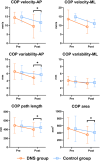Effects of dynamic neuromuscular stabilization training on the core muscle contractility and standing postural control in patients with chronic low back pain: a randomized controlled trial
- PMID: 40025463
- PMCID: PMC11871613
- DOI: 10.1186/s12891-025-08417-1
Effects of dynamic neuromuscular stabilization training on the core muscle contractility and standing postural control in patients with chronic low back pain: a randomized controlled trial
Abstract
Background: Patients with chronic low back pain (CLBP) usually demonstrate poor postural control due to impaired core muscle function. Dynamic neuromuscular stabilization (DNS) is based on developmental kinesiology principles, utilizing infant motor patterns to treat motor disorders. DNS has been shown to improve postural control in cerebral palsy patients by activating core muscle. However, whether the DNS approach is superior for enhancing core muscle contractility and postural control in CLBP patients still remains unclear.
Objectives: This study aimed to compare the effects of DNS training and conventional core exercises on core muscle contractility and standing postural control in CLBP patients.
Methods: Sixty CLBP patients were randomly assigned to a DNS group or a control group. Participants in the DNS group received DNS training, while those in the control group completed conventional core exercises. Both groups completed 12 sessions over 4 weeks (3 sessions/week, 50 min/session). Pre- and post-intervention evaluations included diagnostic musculoskeletal ultrasound to assess the change rate of core muscles (transversus abdominis (TrA), lumbar multifidus, and diaphragm), a balance assessment system to evaluate postural control performance (center of pressure displacement (COP)), and clinical questionnaires (Visual Analog Scale (VAS), Oswestry Disability Index (ODI), and Roland-Morris Disability Questionnaire (RDQ)) for pain intensity and disability.
Results: After 4 weeks, comparisons between both groups revealed significant statistical differences in the interaction effects of time*group. These differences were observed in the change rates of the left and right TrA (F1,58=4.820 and 3.964, p = 0.032 and 0.041), diaphragm change rate (F1,58=11.945, p = 0.001), as well as COP velocity (F1,58=5.283, p = 0.025), variability (F1,58=13.189, p = 0.001) in the anterior-posterior (AP) direction, COP path length (F1,58=6.395, p = 0.014), and COP area (F1,58=5.038, p = 0.029) in the eye-closed condition. DNS participants showed significantly greater muscle change rates and reduced COP (p < 0.05). The scores of VAS (F1,58=173.929, p = 0.001), ODI (F1,58=60.871, p = 0.001), and RDQ (F1,58=60.015, p = 0.001) decreased significantly over time, although no group differences were found between both groups (p > 0.05).
Conclusions: DNS is superior to conventional core exercises in enhancing core muscle contractility and standing postural control in CLBP patients, showing potential to reduce pain and improve disability. Its mechanism may involve the enhancement of proprioceptive feedback, particularly when visual feedback is blocked.
Trial registration: This study was registered in the Chinese Clinical Trial Registry (ChiCTR) with the registration number ChiCTR2300074595 on 10 August 2023.
Keywords: Chronic low back pain; Core muscle; Disability; Dynamic neuromuscular stabilization; Pain intensity; Postural control.
© 2025. The Author(s).
Conflict of interest statement
Declarations. Ethical approval: The studies involving human participants were reviewed and approved by the Institutional Ethics Committee of the First Affiliated Hospital of Sun Yat-sen University (Ethical #: [2023] 324). All participants and respective guardians provided their written informed consent to participate in this study. Consent for publication: All authors have provided their consent for publication. Additionally, all participants have given written informed consent for their personal or clinical details along with any identifying images to be published in this study. Consort: This Randomized Controlled Trial adheres to the CONSORT guidelines. Competing interests: The authors declare no competing interests.
Figures








References
Publication types
MeSH terms
Grants and funding
LinkOut - more resources
Full Text Sources
Medical

